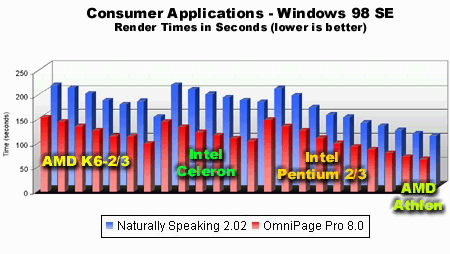Desktop CPU Comparison - September 99
by Anand Lal Shimpi on September 6, 1999 1:23 AM EST- Posted in
- CPUs

Two unique applications that were previously not used for benchmarking, Naturally Speaking and OmniPage Pro are depicted in this graph.
The Celeron performs quite poorly in this benchmark as it measures up, at 500MHz, to a Pentium II 350. The K6-2 and K6-III do surprisingly well in this application, as they even outpace the Celeron in terms of performance. The K6-III 450 is aided by its on-die L2 cache that brings it up to the performance level of a Pentium II at 450MHz, however the SSE optimizations the Pentium III 450 boasts keep the K6-III from hitting that level of performance.
The OmniPage Pro benchmark is a part of the SYSmark 98 suite and stresses one of the most CPU intensive parts of scanning in a document, OCR, or Optical Character Recognition.
The Celeron is again outpaced by the Pentium II/III by about 7 - 10% across the board as the larger L2 cache of the Pentium II/III can hold much more data and is thus more significant to performance in this case than the smaller L2 on the Celeron.
For this same reason, the K6-III with its 256KB of integrated L2 cache gives the Pentium III a nice run for its money here as it comes in just a hair faster than the Pentium III 450. AMD's choice to outfit the K6-III with 256KB of L2 versus 128KB of L2 seems to have been a wise one as the overall performance difference between 128KB and 512KB seems to be much less than that from 256KB to 512KB, making 256KB the sweet spot for CPU manufacturers in terms of a good price to performance ratio. It isn't a surprise that Intel's forthcoming Coppermine will be featuring an integrated 256KB of L2 cache.










0 Comments
View All Comments